NCERT Exemplar Solutions: Comparing Quantities | Mathematics (Maths) Class 7 (Old NCERT) PDF Download
Exercise Page: 196
In questions 1 to 23, there are four options, out of which one is correct. Write the correct one.
Q.1. 20% of 700 m is
(a) 560 m
(b) 70 m
(c) 210 m
(d) 140 m
Ans: (d)
Explanation: 20% of 700 m
The above condition can be written as = (20/100) × 700
= 14000/100
= 140 m
Q.2. Gayatri’s income Rs. 1,60,000 per year. She pays 15% of this as house rent and 10% of the remainder on her child’s education. The money left with her is
(a) Rs.136000
(b) Rs.120000
(c) Rs.122400
(d) Rs.14000
Ans: (c)
Explanation: From the question it is given that,
Gayatri’s income Rs. 1,60,000 per year
She pays 15% of this as house rent = 15% of Rs. 1,60,000
= (15/100) × 1,60,000
= Rs. 24000
10% of the remainder on her child’s education = 10% of remaining amount of her income
Remaining amount of her income = Rs. 1,60,000 – Rs. 24000
= Rs. 136000
Total amount of her child’s education = 10% of Rs. 136000
= (10/100) × 136000
= 1360000/100
= Rs. 13600
Then, money left with Gayatri = Rs. 1,60,000 – (Rs. 24000 + Rs. 13600)
= Rs. 1, 60, 000 – Rs. 37,600
= Rs. 1,22,400
Q.3. The ratio of Fatima’s income to her savings is 4 : 1. The percentage of money saved by her is :
(a) 20%
(b) 25%
(c) 40%
(d) 80%
Ans: (a)
Explanation: Let assume the ratio if Fatima’s income to her savings be 4y : 1y.
Then, the percentage of money saved by her is = (her savings/(income + savings)) × 100
= (1y/4y + y) × 100
= 100/5
= 20
Q.4. 0.07 is equal to
(a) 70%
(b) 7%
(c) 0.7%
(d) 0.07%
Ans: (b)
Explanation: 0.07 = 7/100
Percentage = (7/100) × 100
= 7%
Q.5. In a scout camp, 40% of the scouts were from Gujarat State and 20% of these were from Ahmedabad. The percentage of scouts in the camp from Ahmedabad is
(a) 25
(b) 32.5
(c) 8
(d) 50
Ans: (c)
Explanation: From the question it is given that,
In a scout camp, 40% of the scouts were from Gujarat State
So, let us assume number of scouts in the camp be 100
Then, scouts from Gujarat = 40% of 100
= (40/100) × 100
= 4000/100
= 40
Now, 20% of scouts were from Ahmedabad = 20% of 40
= (20 /100) × 40
= 800/100
= 8
Therefore, the percentage of scouts in the camp from Ahmedabad is 8.
Q.6. What percent of Rs. 4500 is Rs. 9000?
(a) 200
(b) ½
(c) 2
(d) 50
Ans: (a)
Explanation: Let us assume percentage be Q,
Then, Q% of Rs. 4500 is Rs. 9000
(Q/100) × 4500 = Rs. 9000
(4500Q/100) = Rs. 9000
45Q = Rs. 9000
Q = Rs. 9000/45
Q = Rs. 200
Q.7. 5.2 is equal to
(a) 52%
(b) 5.2%
(c) 520%
(d) 0.52%
Ans: (c)
Explanation: 5.2 = (52/10) × 100
= (5200/10)
= 520%
Q.8. The ratio 3 : 8 is equal to
(a) 3.75%
(b) 37.5%
(c) 0.375%
(d) 267%
Ans: (b)
Explanation: The ratio 3 : 8 = (3/8) × 100
= 300/8
= 37.5%
Q.9. 225% is equal to
(a) 9 : 4
(b) 4 : 9
(c) 3 : 2
(d) 2 : 3
Ans: (a)
Explanation: 225% = (225/100)
Because, to remove the % we have to divide the given number by 100.
= 9/4
Q.10. A bicycle is purchased for Rs. 1800 and is sold at a profit of 12%. Its selling price is
(a) Rs. 1584
(b) Rs. 2016
(c) Rs. 1788
(d) Rs. 1812
Ans: (b)
Explanation: From the question it is given that,
A bicycle is purchased for Rs. 1800
Bicycle is sold at a profit of 12%.
Its selling price is =?
We know that, Profit percent = (Profit/CP) × 100
12 = (Profit/Rs. 1800) × 100
(12 × 1800)/100 = Profit
Profit = 12 × 18
Profit = Rs. 216
Then, Profit = SP – CP
216 = SP – 1800
SP = 216 + 1800
SP = Rs. 2016
Q.11. A cricket bat was purchased for Rs. 800 and was sold for Rs. 1600. Then profit earned is
(a) 100%
(b) 64%
(c) 50%
(d) 60%
Ans: (a)
Explanation: From the question it is given that,
Cost price of bat (CP) = Rs. 800
Selling price of bat (SP) = Rs. 1600
Then, Profit = SP – CP
= 1600 – 800
= Rs. 800
We know that, Profit percent = (Profit/CP) × 100
= (800/800) × 100
= 100%
Q.12. A farmer bought a buffalo for Rs. 44000 and a cow for Rs. 18000. He sold the buffalo at a loss of 5% but made a profit of 10% on the cow. The net result of the transaction is
(a) loss of Rs. 200
(b) profit of Rs. 400
(c) loss of Rs. 400
(d) profit of Rs. 200
Ans: (c)
Explanation: From the question it is given that,
Cost price of cow = Rs. 18000
Profit percent on cow = 10%
We know that, Profit percent = (Profit/CP) × 100
10 = (Profit/Rs. 18000) × 100
(10 × 18000)/100 = Profit
Profit = 10 × 180
Profit = Rs. 1800
Then, Profit = SP – CP
1800 = SP – 18000
SP = 1800 + 18000
SP of cow = Rs. 19800
Cost price of buffalo = Rs. 44000
He sold the buffalo at a loss of 5%
We know that, Loss percent = (loss/CP) × 100
5 = (loss/44000) × 100
(5 × 44000)/100 = loss
Loss = 5 × 440
Loss = Rs. 2200
Loss = CP – SP
Rs.2200 = Rs.44000 – SP
SP = 44000 – 2200
SP of buffalo = Rs. 41,800
Now,
Total cost price of both buffalo and cow = Rs. 44000 + Rs. 18000
= Rs. 62000
Total selling price of both buffalo and cow = Rs. 41800 + Rs. 19800
= Rs. 61,600
Selling price of both buffalo and cow is less when compare to cost price,
So, Loss = CP – SP
= Rs. 62000 – Rs. 61600
Loss = Rs. 400
Q.13. If Mohan’s income is 25% more than Raman’s income, then Raman’s income is less than Mohan’s income by
(a) 25%
(b) 80%
(c) 20%
(d) 75%
Ans: (c)
Explanation: Let us assume Mohan’s income be ‘P’ and Raman’s income be ‘Q’
From the question it is given that,
Mohan’s income is 25% more than Raman’s income i.e. x = y + 25% of y
X = y + (25/100) y
X = y (1 + (25/100))
X = y ((100 + 25)/100)
X = y(125/100)
Then, the difference between both the income is = (125/100)y – (25/100)y
So,
Raman’s income as compared to Mohan’s income,
= (difference)/ (Mohan’s income) × 100
= ((25y/100)/(125y/100)) × 100
= (25/125) × 100
= 20%
Q.14. The interest on Rs. 30000 for 3 years at the rate of 15% per annum is
(a) Rs. 4500
(b) Rs. 9000
(c) Rs. 18000
(d) Rs. 13500
Ans: (d)
Explanation: From the question it is given that,
Principal= Rs. 30000
Time = 3 Years
Rate = 15%
Then, we know the formula of Simple interest I = (P × R × T)/100
I = (30000 × (15) × 3)/100
I = (30000 × 15 × 3)/100
I = Rs. 13500
Q.15. Amount received on Rs. 3000 for 2 years at the rate of 11% per annum is
(a) Rs. 2340
(b) Rs. 3660
(c) Rs. 4320
(d) Rs. 3330
Ans: (b)
Explanation: From the question it is given that,
Principal= Rs. 3000
Time = 2 Years
Rate = 11%
Then, we know the formula of Simple interest I = (P × R × T)/100
I = (3000 × (11) × 2)/100
I = (3000 × 11 × 2)/100
I = Rs. 660
Amount = P + I
= 3000 + 660
= Rs. 3660
Q.16. Interest on Rs. 12000 for 1 month at the rate of 10 % per annum is
(a) Rs. 1200
(b) Rs. 600
(c) Rs. 100
(d) Rs. 12100
Ans: (c)
Explanation: From the question it is given that,
Principal= Rs. 12000
Time = 1 month = 1/12
Rate = 10%
Then, we know the formula of Simple interest I = (P × R × T)/100
I = (12000 × (10) × (1/12))/100
I = Rs. 100
Q.17. Rajini and Mohini deposited Rs. 3000 and Rs. 4000 in a company at the rate of 10% per annum for 3 years and 2½ years respectively. The difference of the amounts received by them will be
(a) Rs. 100
(b) Rs. 1000
(c) Rs. 900
(d) Rs. 1100
Ans: (d)
Explanation: From the question it is given that,
Money deposited by Rajini = Rs. 3000
Time = 3 years
Rate = 10%
Then, we know the formula of Simple interest I = (P × R × T)/100
I = (3000× (10) × 3)/100
I = Rs. 900
Amount = P + I
= 3000 + 900
= Rs. 3900
Now,
Money deposited by Mohini = Rs. 4000
Time = 2½ = 5/2
Rate = 10%
Then, we know the formula of Simple interest I = (P × R × T)/100
I = (4000× (10) × (5/2))/100
I = Rs. 1000
Amount = P + I
= 4000 + 1000
= Rs. 5000
The difference of the amounts received by them will be = 5000 – 3900
= Rs.1100
Q.18. If 90% of x is 315 km, then the value of x is
(a) 325 km
(b) 350 km
(c) 405 km
(d) 340 km
Ans: (b)
Explanation: From the question it is given that,
90% of x is 315 km, it can be written as, (90/100) × x = 315
x = (315 × 100)/90
x = 31500/90
x = 350 km
Q.19. On selling an article for Rs. 329, a dealer lost 6%. The cost price of the article is
(a) Rs. 310.37
(b) Rs. 348.74
(c) Rs. 335
(d) Rs. 350
Ans: (d)
Explanation: From the question it is given that,
Selling price of the article = Rs. 329
Loss percent = 6%
We know that, Loss percent = (loss/CP) × 100
6 = ((CP – SP)/CP) × 100
(6/100)CP = CP –SP
CP – (6/100)CP = 329
(94/100)CP = 329
CP = (329 × 100)/94
CP = Rs. 350
Q.20. (25% of 50% of 100%)/(25 × 50) is equal to
(a) 1.1%
(b) 0.1%
(c) 0.01%
(d) 1%
Ans: (c)
Explanation: = [(25/100) × (50/100) × (100/100)]/ (25 × 50)
= [¼ × ½ × 1]/(1250)
= [1/8] × (1/1250)
= 1/10000
= 0.0001 × 100
= 0.01%
Q.21. The sum which will earn a simple interest of Rs. 126 in 2 years at 14% per annum is
(a) Rs. 394
(b) Rs. 395
(c) Rs. 450
(d) Rs. 540
Ans: (c)
Explanation: From the question it is given that,
SI = Rs. 126
Time = 2 years
Rate = 14%
Then, we know the formula of Simple interest I = (P × R × T)/100
126 = (P × 14 × 2)/100
P = 12600/(14 × 2)
P = Rs. 450
Q.22. The per cent that represents the unshaded region in the figure
(a) 75%
(b) 50%
(c) 40%
(d) 60%
Ans: (c)
Explanation: From the figure,
Total number of parts in the given figure = 10 × 10 = 100
Out of 100 parts 60 parts are shaded.
So, unshaded parts = 100 – 60 = 40 parts
Then percentage of unshaded parts = (40/100) × 100
= 0.4 × 100
= 40%
Q.23. The per cent that represents the shaded region in the figure is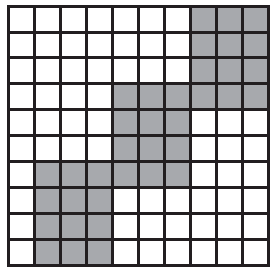
(a) 36%
(b) 64%
(c) 27%
(d) 48%
Ans: (a)
Explanation: From the figure,
Total number of parts in the given figure = 10 × 10 = 100
Out of 100 parts 36 parts are shaded.
Then percentage of shaded parts = (36/100) × 100
= 0.36 × 100
= 36%
In each of the questions 24 to 59, fill in the blanks to make the statements true.
Q.24. 2 : 3 = ________ %
Solution: 2: 3 =
= (2/3) × 100
= 
Q.25. 18¾% = :
Solution: 18¾% = 3 : 16
18¾% = 75/4 %
= (75/4) × (1/100)
= 3: 16
Q.26. 30% of Rs. 360 = ________.
Solution: 30% of Rs. 360 = Rs. 108.
It can be written as = (30/100) × 360
= 10800/100
= Rs. 108
Q.27. 120 % of 50 km = ________.
Solution: 120 % of 50 km = 60 km.
It can be written as = (120/100) × 50
= 6000/100
= 60 km
Q.28. 2.5 = ________%
Solution: 2.5 = 250 %
2.5 = 2.5 × 100
= 250%
Q.29. (8/5) = %
Solution: (8/5) = 160 %.
(8/5) is written in percentage as = (8/5) × 100
= 8 × 20
= 160 %
Q.30. A _______ with its denominator 100 is called a percent.
Solution: A fraction with its denominator 100 is called a percent.
Q.31. 15 kg is _______ % of 50 kg.
Solution: 15 kg is 30 % of 50 kg.
Let us assume the percentage be P.
So, P% of 50 kg =15 kg
(P/100) × 50 = 15
P = (15 × 100)/50
P = 1500/50
P = 150/5
P = 30
Q.32. Weight of Nikhil increased from 60 kg to 66 kg. Then, the increase in weight is _______ %.
Solution: Weight of Nikhil increased from 60 kg to 66 kg. Then, the increase in weight is 10 %.
From the question it is given that, Weight of Nikhil increased from 60 kg to 66 kg.
So, weight increase = 66 – 60
= 6 kg
Then, percentage increase = (Weight increase/Initial weight) × 100%
= (6/60) × 100
= 600/60
= 60/6
= 10%
Q.33. In a class of 50 students, 8 % were absent on one day. The number of students present on that day was ________.
Solution: In a class of 50 students, 8 % were absent on one day. The number of students present on that day was 46.
From the question it is given that, number of students in the class = 50
Percentage of students were absent on one day = 8%
Then, percentage of students were present on one day = 100% – 8%
= 92%
So, 92% of 50
= (92/100) × 50
= 4600/100
= 46 students
Q.34. Savitri obtained 440 marks out of 500 in an examination. She secured _______ % marks in the examination.
Solution: Savitri obtained 440 marks out of 500 in an examination. She secured 88% marks in the examination.
From the question it is give that, Savitri obtained 440 marks out of 500 in an examination,
Then, percentage of marks obtained by Savitri = (440/500) × 100
= 0.88 × 100
= 88%
Q.35. Out of a total deposit of Rs. 1500 in her bank account, Abida withdrew 40% of the deposit. Now the balance in her account is ______.
Solution: Out of a total deposit of Rs. 1500 in her bank account, Abida withdrew 40% of the deposit. Now the balance in her account is Rs. 900.
From the question,
Total deposit in Abida’s account = Rs. 1500
Percentage of amount Abida withdrew = 40%
Then, amount withdrew = 40% of Rs. 1500
= (40/100) × 1500
= 60000/100
= Rs. 600
Then, remaining amount in the account = Rs. 1500 – Rs. 600
= Rs. 900
Q.36. ________ is 50% more than 60.
Solution: 90 is 50% more than 60.
Let us assume the number be Q.
From the question, Q is 50% more than 60
So, Q = 60 + (50/100) × 60
= 60 + (3000/100)
= 60 + 30
= 90
Q.37. John sells a bat for Rs. 75 and suffers a loss of Rs. 8. The cost price of the bat is________.
Solution: John sells a bat for Rs. 75 and suffers a loss of Rs. 8. The cost price of the bat is Rs. 83.
From the question it is given that, Selling price of bat Rs. 75
Loss = Rs. 8
We know that, Cost Price (CP) = SP + loss
= Rs. 75 + Rs. 8
= Rs. 83
Q.38. If the price of sugar is decreased by 20%, then the new price of 3kg sugar originally costing Rs. 120 will be
Solution: If the price of sugar is decreased by 20%, then the new price of 3kg sugar originally costing Rs. 120 will be Rs. 96
From the question it is given that, price of 3kg sugar originally costing Rs. 120
The price of the sugar is decreased by 20%
Then, the new price of sugar = 120 – 20% of original price
= 120 – (20/100) × 120
= 120 – (2400/100)
= 120 – 24
= Rs. 96
Q.39. Mohini bought a cow for Rs. 9000 and sold it at a loss of Rs. 900. The selling price of the cow is ________.
Solution: Mohini bought a cow for Rs. 9000 and sold it at a loss of Rs. 900. The selling price of the cow is Rs. 8100
From the question it is given that,
Cost price of cow (CP) = Rs. 9000
Loss = Rs. 900
We know that, Selling price (SP) = CP – loss
= 9000 – 900
= Rs. 8100
Q.40. Devangi buys a chair for Rs. 700 and sells it for Rs. 750. She earns a profit of ________ % in the transaction.
Solution: Devangi buys a chair for Rs. 700 and sells it for Rs. 750. She earns a profit of  % in the transaction.
% in the transaction.
From the question it is given that, cost price of chair = Rs. 700
As we know that, Profit = SP – CP
= 750 – 700
= Rs. 50
Then, Profit percentage = (profit/CP) × 100%
= (50/700) × 100
= 
Q.41. Sonal bought a bed sheet for Rs. 400 and sold it for Rs. 440. Her ________% is ________.
Solution: Sonal bought a bed sheet for Rs. 400 and sold it for Rs. 440. Her Profit% is 10.
From the question, it is given that, cost price of bed = Rs. 400
Selling price of bed = Rs. 440
SP is more than CP so, Profit = SP – CP
= 440 – 400
= Rs. 40
We know that, Profit percentage = (Profit/CP) × 100
= (40/400) × 100
= 10%
Q.42. Nasim bought a pen for Rs. 60 and sold it for Rs. 54. His ________% is ________.
Solution: Nasim bought a pen for Rs. 60 and sold it for Rs. 54. His loss% is 10.
From the question, it is given that, cost price of pen = Rs. 60
Selling price of pen = Rs. 54
CP is more than SP so, Loss = CP – SP
= 60 – 54
= Rs. 6
We know that, loss percentage = (loss/CP) × 100
= (6/60) × 100
= 10%
Q.43. Aahuti purchased a house for Rs. 50,59,700 and spent Rs. 40300 on its repairs. To make a profit of 5%, she should sell the house for Rs. ________.
Solution: Aahuti purchased a house for Rs. 50,59,700 and spent Rs. 40300 on its repairs. To make a profit of 5%, she should sell the house for Rs. 5355000.
From the question it is give that,
Cost price of house purchased by Aahuti = Rs. 50,59,700
Amount spent to repair the house = Rs. 40,300
Then, total cost price of house = Rs. 50,59,700 + 40,300
= Rs. 5100000
Profit % = (profit/CP) × 100
5 = ((SP – CP)/CP) × 100
5 = ((SP – 5100000)/5100000) × 100
(5 × 5100000)/100 = SP – 5100000
SP = Rs. 5355000
Q.44. If 20 lemons are bought for Rs. 10 and sold at 5 for three rupees, then ________ in the transaction is ________%.
Solution: If 20 lemons are bought for Rs. 10 and sold at 5 for three rupees, then profit in the transaction is 20%.
From the question, it is given that, cost price of 20 lemons = Rs. 10
Selling price of 5 lemons = Rs. 3
So, selling price of 1 lemon = Rs. 3/5
Then, selling price of 20 lemons = Rs. (3/5) × 20
= 12
SP is more than CP so, Profit = SP – CP
= 12 – 10
= Rs. 2
We know that, Profit percentage = (Profit/CP) × 100
= (2/10) × 100
= 20%
Q.45. Narain bought 120 oranges at Rs. 4 each. He sold 60 % of the oranges at Rs. 5 each and the remaining at Rs. 3.50 each. His ________ is ________%.
Solution: Narain bought 120 oranges at Rs. 4 each. He sold 60 % of the oranges at Rs. 5 each and the remaining at Rs. 3.50 each. His profit is 10%.
From the question, it is given that, cost price of one orange = Rs. 4
cost price of 120 oranges = Rs. 4 × 120 = Rs. 480
So, selling price of 60% of oranges = Rs. 5 per each
60% of 120 oranges = (60/100) × 120
= 7200/100
= 72 oranges
Selling price of 72 oranges = 72 × 5 = Rs. 360
SP of remaining oranges = (120 – 72) × 3.50
= 48 × 3.50
= Rs. 168
Therefore total selling price of 120 oranges = Rs. 360 + Rs. 168
= Rs. 528
SP is more than CP so, Profit = SP – CP
= 528 – 480
= Rs. 48
We know that, Profit percentage = (Profit/CP) × 100
= (48/480) × 100
= 10%
Q.46. A fruit seller purchased 20 kg of apples at Rs. 50 per kg. Out of these, 5% of the apples were found to be rotten. If he sells the remaining apples at Rs. 60 per kg, then his _________is _________%.
Solution: A fruit seller purchased 20 kg of apples at Rs. 50 per kg. Out of these, 5% of the apples were found to be rotten. If he sells the remaining apples at Rs. 60 per kg, then his profit is 14 %.
From the question it is given that, A fruit seller purchased 20 kg of apples at Rs. 50 per kg
In that 20 kg of apples 5% were rotten, so good apples = 20 – 5% of 20kg
= 20 – (5/100) × 20
= 20 – (100/100)
= 20 – 1
= 19 kg
So, 19 kg apples were sold at Rs. 60 per kg
Then, total Selling price of apples = 19 × 60
= Rs. 1140
Given cost price of 20 kg of apples = 20 × 50
= Rs. 1000
SP is more than CP so, Profit = SP – CP
= 1140 – 1000
= Rs. 140
We know that, Profit percentage = (Profit/CP) × 100
= (140/1000) × 100
= 14%
Q.47. Interest on Rs. 3000 at 10% per annum for a period of 3 years is ________.
Solution: Interest on Rs. 3000 at 10% per annum for a period of 3 years is Rs. 900.
From the question it is given that,
Principal= Rs. 3000
Time = 3 years
Rate = 10%
Then, we know the formula of Simple interest I = (P × R × T)/100
I = (3000 × (10) × 3)/100
I = Rs. 900
Q.48. Amount obtained by depositing Rs. 20,000 at 8 % per annum for six months is ________.
Solution: Amount obtained by depositing Rs. 20,000 at 8 % per annum for six months is Rs. 20800
From the question it is given that,
Principal= Rs. 20000
Time = 6 months = 6/12 = ½
Rate = 8%
Then, we know the formula of Simple interest I = (P × R × T)/100
I= (20000 × 8 × ½ ) /100
I = Rs. 800
Amount received = Principal + Interest
= 20000 + 800
= Rs. 20800
Q.49. Interest on Rs. 12500 at 18% per annum for a period of 2 years and 4 months is ________.
Solution: Interest on Rs. 12500 at 18% per annum for a period of 2 years and 4 months is Rs. 5250.
From the question it is given that,
Principal= Rs. 12500
Time = 2 years 4 months = (2 + (4/12))
= (2 + (1/3))
= 7/3 year
Rate = 18%
Then, we know the formula of Simple interest I = (P × R × T)/100
I = (12500 × 18 × (7/3)) /100
I = Rs. 5250
Q.50. 25 ml is _________ percent of 5 litres.
Solution: 25 ml is 0.5 percent of 5 litres
Let us assume 25 ml be Q % of 5 liters.
So, 25 ml = Q % of 5l
25 = (Q/100) × 5 × 1000
Q = (25 × 100)/(5 × 1000)
Q = 0.5%
Q.51. If A is increased by 20%, it equals B. If B is decreased by 50%, it equals C. Then __________ % of A is equal to C.
Solution: If A is increased by 20%, it equals B. If B is decreased by 50%, it equals C. Then 60 % of A is equal to C.
From the question it is given that, A is increased by 20%, it equals B = A + (20/100) × A
B is decreased by 50%, it equals C = B – (50/100) × B
Then,
A (1 + (1/5)) = B
(6/5) A = B … [equation i]
Now,
B (1 – (1/2)) = C
½B = C
B = 2C … [equation ii]
Substitute equation (ii) in equation (i)
(6/5)A = 2C
C = (6/10) A
C = ((6 × 10)/(10 × 10))A
C = (60/100) × A
C = 60% of A
Q.52. Interest = (P × R × T)/100, where
T is
R % is and
P is.
Solution: Interest = (P × R × T)/100, where
T is Time period
R % is Rate of Interest and
P is Principal.
Q.53. The difference of interest for 2 years and 3 years on a sum of Rs. 2100 at 8% per annum is _________.
Solution: The difference of interest for 2 years and 3 years on a sum of Rs. 2100 at 8% per annum is Rs. 168.
From the question it is given that,
P = Rs. 2100
Time = 2 years
Rate = 8%
Then, we know the formula of Simple interest I = (P × R × T)/100
I = (2100 × 2 × 8)/100
I = 33600/100
I = Rs. 336
Then,
Time = 3 years
I = (P × R × T)/100
I = (2100 × 3× 8)/100
I = 50400/100
I = Rs. 504
The difference of interest for 2 years and 3 years = 3 years – 2 years
= Rs. 504 – Rs. 336
= Rs. 168
Q.54. To convert a fraction into a percent, we _________ it by 100.
Solution: To convert a fraction into a percent, we multiply it by 100.
Q.55. To convert a decimal into a percent, we shift the decimal point two places to the _________.
Solution: To convert a decimal into a percent, we shift the decimal point two places to the right.
Q.56. The _________ of interest on a sum of Rs. 2000 at the rate of 6% per annum for 1½ years and 2 years is Rs. 420.
Solution: The sum of interest on a sum of Rs. 2000 at the rate of 6% per annum for 1½ years and 2 years is Rs. 420.
From the question it is given that, P = 2000, R = 6% and T = 1½ years
As we know that,
I = (P × R × T)/100
I = (2000 × 6 × 3)/ (100 × 2)
I = Rs. 180
For 2 years,
I = (P × R × T)/100
I = (2000 × 6 × 2)/ (100)
I = Rs. 240
Then, sum = 180 + 240 = Rs. 420
Q.57. When converted into percentage, the value of 6.5 is _________ than 100%.
Solution: When converted into percentage, the value of 6.5 is more than 100%.
Given, 6.5
= 6.5 × 100
= 650%
In questions 58 and 59, copy each number line. Fill in the blanks so that each mark on the number line is labelled with a percent, a fraction and a decimal. Write all fractions in lowest terms.
Q.58. 
Solution: We know that, Percentage = Fraction × 100
Then, Fraction = Percentage /100
Decimal = Percentage/ 100
Q.59.
Solution: We know that, Percentage = Fraction × 100
Then, Fraction = Percentage /100
Decimal = Percentage/ 100
In questions 60 to 70, state whether the statements are True or False.
60. (2/3) =
Solution:
True
= (2/3) × 100%
= 200/3
=
Q.61. When an improper fraction is converted into percentage then the answer can also be less than 100.
Solution: False
For example consider an improper fraction = 9/4
So, percentage of improper fraction = (9/4) × 100 = 225%
Q.62. 8 hours is 50% of 4 days.
Solution: False
Let us assume 8 hours be Q% of 4 days
So, 8 = (Q/100) × 4 × 24
Q = 25/3
Q = 
Q.63. The interest on Rs. 350 at 5% per annum for 73 days is Rs. 35.
Solution: False
From the question it is given that, P = Rs. 350, R = 5%, T = 73 days = 73/365
As we know that,
I = (P × R × T)/100
I = (350 × 5 × 73)/ (100 × 365)
I = Rs. 3.5
Q.64. The simple interest on a sum of Rs. P for T years at R% per annum is given by the formula: Simple Interest = ((P × R × T)/100)
Solution: True
Q.65. 75% = (4/3)
Solution: False
Because, 75 % = 75/100
= ¾
Q.66. 12% of 120 is 100.
Solution: False
= (12/100) × 120
= 1440/100
= 14.4
Q.67. If Ankita obtains 336 marks out of 600, then percentage of marks obtained by her is 33.6.
Solution: False
From the question it is given that,
Ankita obtains 336 marks out of 600
So, percentage of marks = (336/600) × 100
= 0.56 × 100
= 56%
Q.68. 0.018 is equivalent to 8%.
Solution: False
0.018 × 100 = 1.8%
Q.69. 50% of Rs. 50 is Rs. 25.
Solution: True.
= (50/100) × 50
= 0.5 × 50
= Rs. 25
Q.70. 250 cm is 4% of 1 km.
Solution: False
250 cm = 250/100
= 2.5 m
We know that, 1 km = 1000m
Then, 4 % of 1 km = (4/100) × 1000
= 40 m
Q.71. Out of 600 students of a school, 126 go for a picnic. The percentage of students that did not go for the picnic is 75.
Solution: False
Total number of students = 600
Number of students went on a picnic = 126
∴ Number of students who did not go for the picnic = 600 – 126 = 474
Percentage of students who did not go for the picnic
Q.72. By selling a book for Rs. 50, a shopkeeper suffers a loss of 10%. The cost price of the book is Rs. 60.
Solution: False
Selling price of a book = Rs. 50
Loss % = Rs. 10
We know that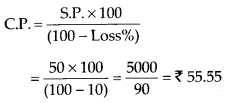
So, the cost price of the book is Rs. 55.5.
Q.73. If a chair is bought for Rs. 2000 and is sold at a gain of 10%, then selling price of the chair is Rs. 2010.
Solution: False
C.P. of a chair = Rs. 2000
Gain % = 10
We know that,
Q.74. If a bicycle was bought for Rs. 650 and sold for Rs. 585, then the percentage of profit is 10.
Solution: False
C.P. of a bicycle = Rs. 650
S.P. of the bicycle = Rs. 585
Therefore, there is a loss of Rs. (650 – 585) = Rs. 65
Q.75. Sushma sold her watch for Rs. 3320 at a gain of Rs. 320. For earning a gain of 10% she should have sold the watch for Rs. 3300
Solution: True
S.P. of a watch = Rs. 3320
Gain = Rs. 320
∴ C.P. of the watch = Rs. (3320 – 320) = Rs. 3000
Required gain % = 10
So, for earning again of 10% Sushma should have sold the watch for Rs. 3300
Q.76. Interest on Rs. 1200 for  years at the rate of 15% per annum is Rs. 180.
years at the rate of 15% per annum is Rs. 180.
Solution: False
Principal = Rs. 1200,
Time
Rate = 15% p.a.
Q.77. The amount received after depositing Rs. 800 for a period of 3 years at the rate of 12% per annum is Rs. 896.
Solution: False
Principal = Rs. 800, Time = 3 years
Rate = 12% p.a.
Now, amount = Principal + Interest
= Rs. (800 + 288) = Rs. 1088
Q.78. Rs. 6400 were lent to Feroz and Rashmi at 15% per annum for  and 5 years respectively. The difference in the interest paid by them is Rs. 150.
and 5 years respectively. The difference in the interest paid by them is Rs. 150.
Solution: False
For Feroz: Principal = Rs. 6400,
Rate = 15% p.a.
For Rashmi : Principal = 6400,
Rate = 15% p.a.
Time = 5 years
Required difference in interests
= Rs. (4800 – 3360) = Rs. 1440
Q.79. A vendor purchased Rs. 120 lemons at 120 per hundred. 10% of the lemons were found rotten which he sold at Rs. 50 per hundred. If he sells the remaining lemons at Rs. 125 per hundred, then his profit will be 16%.
Solution: False
Total number of lemons = 720
C.P. of 100 lemons = Rs. 120
Rotten lemons = 10%
Number of remaining lemons which are not rotten = 720 – 72 = 648
S.P. of 720 lemons = Rs. (36 + 810) = Rs. 846
Here, C.P. > S.P.
Therefore, there is a loss of Rs. (864 – 846) = Rs. 18
Q.80. Find the value of x if
(i) 8% of Rs. x is Rs. 100
(ii) 32% of x kg is 400 kg
(iii) 35% of Rs. x is Rs. 280
(iv) 45% of marks x is 405.
Solution: (i) 8% of Rs. x = Rs. 100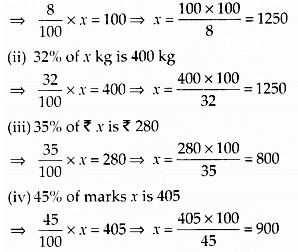
Q.81. Imagine that a 10 × 10 grid has value 300 and that this value is divided evenly among the small squares. In other words, each small square is worth 3. Use a new grid for each part of this problem, and label each grid “Value: 300”.
(a) Shade 25% of the grid. What is 25% of 300? Compare the two answers.
(b) What is the value of 25 squares?
(c) Shade 17% of the grid. What is 17% of 300? Compare the two answers.
(d) What is the value of 1/10 of the grid?
Solution:
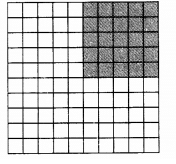
Now, each small square is worth 3
∴ 25 small square worths 25 × 3 = 75
Both the values are same.
(b) From part (a), value of 25 small squares is 75.

Now, each small square is worth 3
∴ 17 small square worths 17 × 3 = 51
Both the values are same.
(d) Total numbers in grid = 10 × 10 = 100
Each small square is worth 3
∴ 10 small square worths 10 × 3 = 30
Q.82. Express 1/6 as a percent.
Solution:
Q.83. Express  as a percent.
as a percent.
Solution: 
Q.84. Express  as a percent.
as a percent.
Solution: 
Q.85. Express 80% as fraction in its lowest term.
Solution: 
Q.86. Express  as a ratio in the lowest term.
as a ratio in the lowest term.
Solution: 
Q.87. Express  as a ratio in the lowest form.
as a ratio in the lowest form.
Solution: 
Q.88. Express 150% as a ratio in the lowest form.
Solution:
Q.89. Sachin and Sanjana are calculating 23% of 800.
Now calculate 52% of 700 using both the ways described above. Which way do you find easier?
Solution: I : 52% of 700 = (1% of 700) × 52
= (0.01 × 700) × 52
= 7 × 52 = 364
We find that the way II is easier.
Q.90. Write 0.089 as a percent.
Solution: 
Q.91. Write 1.56 as a percent.
Solution: 
Q.92. What is 15% of 20?
Solution: 
Q.93. What is 800% of 800?
Solution: 
Q.94. What is 100% of 500?
Solution:
Q.95. What percent of 1 hour is 30 minutes?
Solution: Let x% of 1 hour is 30 minutes.
Now, 1 hour = 60 minutes
Q.96. What percent of 1 day is 1 minute?
Solution: Let x% of 1 day is 1 minute,
Now, 1 day – 24 hours = (24 × 60) minutes
Q.97. What percent of 1 km is 1000 metres?
Solution: Let % of 1 km is 1000 metres.
Now, 1 km = 1000 metres
Q.98. Find out 8% of 25 kg.
Solution: 
Q.99. What percent of Rs. 80 is Rs. 100?
Solution: Let x% of Rs. 80 is Rs. 100
Q.100. 45% of the population of a town are men and 40% are women. What is the percentage of children?
Solution: Total percentage = 100
Percentage of men = 45
Percentage of women = 40
∴ Percentage of children = 100 – (45 + 40) = 100 – 85 = 15
Q.101. The strength of a school is 2000. If 40% of the students are girls then how many boys are there in the school?
Solution: Total number of students = 2000
= 800
∴ Number of boys = 2000 – 800 = 1200
Q.102. Chalk contains 10% calcium, 3% carbon and 12% oxygen. Find the amount of carbon and calcium (in grams) in  of chalk.
of chalk.
Solution: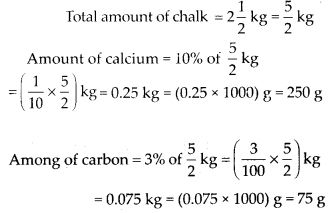
Q.103. 800 kg of mortar consists of 55% sand, 33% cement and rest lime. What is the mass of lime in mortar?
Solution: Total mass of mortar = 800 kg
Mass of sand in mortar = 55% of 800 kg
Mass of cement in mortar = 33% of 800 kg
∴ Mass of lime in mortar = [800 – (440 + 264)] kg = 96 kg
Q.104. In a furniture shop, 24 tables were bought at the rate of Rs. 450 per table. The shopkeeper sold 16 of them at the rate of Rs. 600 per table and the remaining at the rate of Rs. 400 per table. Find her gain or loss percent.
Solution: C.P. of 1 table = Rs. 450
∴ C.P. of 24 tables = Rs. (24 × 450) = Rs. 10800
S.P. of 16 tables = Rs. {(16 × 600) = Rs. 9600
S.P. of remaining tables i.e., 8 tables
= Rs. (8 × 400) = 3200
S.P. of 24 tables = Rs. (9600 + 3200) = Rs. 12800
Here, S.P. > C.P.
Therefore, there is a gain of Rs. (12800 – 10800) = Rs. 2000
Q.105. Medha deposited 20% of her money in a bank. After spending 20% of the remainder, she has Rs. 4800 left with her. How much did she originally have?
Solution: Let the amount of money Medha had Rs. x.
Amount of money deposited in bank = 20% of x




According to question,

Q.106. The cost of a flower vase got increased by 12%. If the current cost is Rs. 896, what was its original cost?
Solution: Let the original cost of a flower vase = Rs. x
Cost of the flower vase after increased by
According to question,
Q.107. Radhika borrowed Rs. 12000 from her friends. Out of which Rs. 4000 were borrowed at 18% and the remaining at 15% rate of interest per annum. What is the total interest after 3 years?
Solution: Total amount borrowed by Radhika = Rs. 12000
I: Principal = Rs. 4000, Rate = 18% p.a.,
Time = 3 years
II: Principal = Rs. (12000 – 4000) = Rs. 8000,
Rate = 15%, Time = 3 years
Total interest = Rs. (2160 + 3600) = Rs. 5760
Q.108. A man travelled 60 km by car and 240 km by train. Find what percent of total journey did he travel by car and what percent by train?
Solution: Distance travelled by car = 60 km
Distance travelled by train = 240 km
Total distance travelled = (60+240) km = 300 km
Percentage of journey travelled by car
Percentage of journey travelled by train
Q.109. By selling a chair for Rs. 1440, a shopkeeper loses 10%. At what price did he buy it?
Solution: S.P. of a chair = Rs. 1440
Loss% = 10

So, the shopkeeper bought the chair at Rs. 1600.
Q.110. Dhruvika invested money for a period from May 2006 to April 2008 at rate of 12% per annum. If interest received by her is Rs. 1620, find the money invested.
Solution: Let the principal be Rs. P.
Rate = 12% p.a., Interest = Rs. 1620
Time = 2 years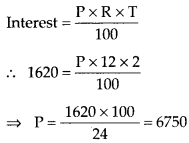
So, amount of money invested by Dhruvika is Rs. 6750.
Q.111. A person wanted to sell a scooter at a loss of 25%. But at the last moment he changed his mind and sold the scooter at a loss of 20%. If the difference in the two SP’s is Rs. 4000, then find the CP of the scooter.
Solution: Let the C.P. of a scooter = Rs. x
S.P. of the scooter for a loss of 25%
S.P. of the scooter for a loss of 20%
Difference in both S.P.’s of the scooter
According to question,
⇒ x = 4000 × 20 = 80000
Q.112. The population of a village is 8000. Out of these, 80% are literate and of these literate people, 40% are women. Find the ratio of the number of literate women to the total population.
Solution: Total population of a village = 8000
Number of literate people = 80% of 8000
Number of literate women = 40% of 6400
Required Ratio = 
Q.113. In an entertainment programme, 250 tickets of Rs. 400 and 500 tickets of Rs. 100 were sold. If the entertainment tax is 40% on ticket of Rs. 400 and 20% on ticket of Rs. 100, find how much entertainment tax was collected from the programme.
Solution: Cost of 250 tickets of Rs. 400 per ticket
= Rs. (250 × 400) = Rs. 100000
Cost of 500 tickets of Rs. 100 per ticket
= Rs. (500 × 100) = Rs. 50000
Tax on tickets of Rs. 400
Tax on tickets of 100
So, total tax collected from the programme
= Rs. (40000 + 10000) = Rs. 50000
Q.114. Bhavya earns Rs. 50,000 per month and spends 80% of it. Due to pay revision, her monthly income increases by 20% but due to price rise, she has to spend 20% more. Find her new savings.
Solution: Monthly income of Bhavya = Rs. 50000
Spending amount = 80% of Rs. 50000
New income – 20% of 50000 + 50000
= Rs. 60000
New spending amount = 40000 + 20% of 40000
= 40000 + 8000 = Rs. 48000
∴ New savings of Bhavya
= Rs. (60000 – 48000) = Rs. 12000
Q.115. In an examination, there are three papers each of 100 marks. A candidate obtained 53 marks in the first and 75 marks in the second paper. How many marks must the candidate obtain in the third paper to get an overall of 70 percent marks?
Solution: Total marks = 100 + 100 + 100 = 300
Marks obtained by the candidate in first paper = 53
Marks obtained by the candidate in second paper = 75
Let the marks obtained by the candidate in third paper = x
Total marks obtained by the candidate = 53 + 75 + x – 128 + x
According to question,
⇒ 128 + x = 3x 70
⇒ x = 210 – 128 = 82
So, the candidate must obtain 82 marks in the third paper.
Q.116. Health Application A doctor reports blood pressure in millimetres of mercury (mm Hg) as a ratio of systolic blood pressure to diastolic blood pressure (such as 140 over 80). Systolic pressure is measured when the heart beats, and diastolic pressure is measured when it rests. Refer to the table of blood pressure ranges for adults.
Manohar is a healthy 37 years old man whose blood pressure is in the normal category.
(a) Calculate an approximate ratio of systolic to diastolic blood pressures in the normal range.
(b) If Manohar’s systolic blood pressure is 102 mm Hg, use the ratio from part (a) to predict his diastolic blood pressure.
(c) Calculate ratio of average systolic to average diastolic blood pressure in the prehypertension category.
Solution: (a) Systolic blood pressure in the normal range = 120 mm Hg
Diastolic blood pressure in the normal range = 80 mm Hg
(b) Systolic blood pressure of Manohar = 102 mm Hg
⇒ Diastolic blood pressure
(c) Average systolic blood pressure in the prehypertension category
Average diastolic blood pressure in the prehypertension category

Q.117. (a) Science Application: The king cobra can reach a length of 558 cm. This is only about 60 per cent of the length of the largest reticulated python. Find the length of the largest reticulated python.
(b) Physical Science Application: Unequal masses will not balance on a fulcrum if they are at equal distance from it; one side will go up and the other side will go down. Unequal masses will balance when the following proportion is true:
Two children can be balanced on a Seesaw when  The child on the left and child on the right are balanced. What is the mass of the child on the right?
The child on the left and child on the right are balanced. What is the mass of the child on the right?
(c) Life Science Application: A DNA model was built using the scale 2 cm : 0.0000001 mm. If the model of the DNA chain is 17 cm long, what is the length of the actual chain?
Solution: (a) Let the length of the largest reticulated python – x cm
According to question,
60% of x = 558
⇒ x = 930
(b) We have,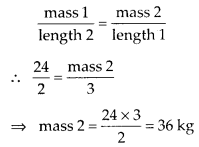
(c) Length of actual chain 0.0000001 mm is measured as 2 cm in the model.
∴ Length of actual chain when length of chain is 17 cm in the model
Q.118. Language Application
Given below are few Mathematical terms.
Find
(a) The ratio of consonants to vowels in each of the terms.
(b) The percentage of consonants in each of the terms.
Solution:
(a) (i) Number of consonants in Hypotenuse’ = 6
Number of vowels in ‘Hypotenuse’ = 4
(ii) Number of consonants in ‘Congruence’ = 6
Number of vowels in ‘Congruence’ = 4
(iii) Number of consonants in ‘Perpendicular’ = 8
Number of vowels in ‘Perpendicular = 5
(iv) Number of consonants in ‘Transversal’ = 8
Number of vowels in ‘Transversal’ = 3
(v) Number of consonants in ‘Correspondence’ = 9
Number of vowels in ‘Correspondence’ = 5
(b)(i) Percentage of consonants in ‘Hypotenuse’
(ii) Percentage of ‘consonants in Congruence’
(iii) Percentage of consonants in ‘Perpendicular’
(iv) Percentage of consonants in ‘Transversal’
(v) Percentage of consonants in ‘Correspondence’
Q.119. What’s the Error? An analysis showed that 0.06 per cent of the T-shirts made by one company were defective. A student says this is 6 out of every 100. What is the student’s error?
Solution: 
Therefore 6 out of every 10000 are defective T-shifts.
Q.120. What’s the Error? A student said that the ratios  were proportional. What error did the student make?
were proportional. What error did the student make?
Solution: 
Therefore are not proportional.
are not proportional.
Q121. What’s the Error? A clothing store charges Rs. 1024 for 4 T-shirts. A student says that the unit price is Rs. 25.6 per T-shirt. What is the error? What is the correct unit price?
Solution: Cost price for 4 T-shirts = Rs. 1024 .
Therefore correct unit price is Rs. 256.
Q.122. A tea merchant blends two varieties of tea in the ratio of 5 : 4. The cost of first variety is Rs. 200 per kg and that of second variety is Rs. 300 per kg. If he sells the blended tea at the rate of Rs. 275 per kg, find out the percentage of her profit or loss.
Solution: Let quantity of first variety and second variety of tea be 5x kg and 4x kg respectively.
Cost of first variety of tea = Rs. (200 × 5x) = Rs. 1000 x
Cost of second variety of tea = Rs. (300 × 4x) = Rs. 1200x
Total cost price of tea = Rs. (1000x + 1200x) = Rs. 2200x
Selling price of tea = Rs. (9x × 275) = Rs. 2475x
Here, S.P. > C.P.
Therefore, there is a profit of = Rs. (2475x – 2200x) = Rs. 275x
Q.123. A piece of cloth 5 m long shrinks 10 percent on washing. How long will the cloth be after washing?
Solution: Length of cloth = 5m
Shrinking percentage after washing = 10%
∴ Length of cloth, after washing
= 5 – 10% of 5
Q.124. Nancy obtained 426 marks out of 600 and the marks obtained by Rohit are 560 out of 800. Whose performance is better?
Solution: Percentage of marks obtained by Nancy
Percentage of marks obtained by Rohit
So, Nancy’s performance is better.
Q.125. A memorial trust donates Rs. 5,00,000 to a school, the interest on which is to be used for awarding 3 scholarships to students obtaining first three positions in the school examination every year. If the donation earns an interest of 12 percent per annum and the values of the second and third scholarships are Rs. 20,000 and Rs. 15,000 respectively, find out the value of the first scholarship.
Solution: Total donation amount = Rs. 500000
Interest on donation amount
Value of the second and third scholarships = Rs. (20000 + 15000) = Rs. 35000
Now, value of the first scholarship = Rs. (60000 – 35000) = Rs. 25000
Q.126. Ambika got 99 per cent marks in Mathe matics, 76 per cent marks in Hindi, 61 percent in English, 84 per cent in Science, and 95% in Social Science. If each subject carries 100 marks, then find the percentage of marks obtained by Ambika in the aggregate of all the subjects.
Solution: Total maximum marks = 5 × 100 = 500
Total marks obtained by Ambika in all subjects = 99 + 76 + 61 + 84 + 95 = 415
Percentage of marks obtained by Ambika
Q.127. What sum of money lent out at 16 percent per annum simple interest would produce Rs. 9600 as interest in 2 years?
Solution: S.I. = Rs. 9600, Time = 2 years,
Rate = 16% p.a.
We know that,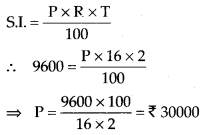
Q.128. Harish bought a gas-chullah for Rs. 900 and later sold it to Archana at a profit of 5 percent. Archana used it for a period of two years and later sold it to Babita at a loss of 20 percent. For how much did Babita get it?
Solution: For Harish: C.P. = Rs. 900, Profit % = 5
Now, S.P. for Harish would be the C.P. for Archana.
For Archana : C.P. = Rs. 945, Loss % = 20
Again, S.P. for Archana would be the C.P. for Babita.
So, Babita got the gas-chullah for Rs. 756.
Q.129. Match each of the entries in Column with the appropriate entries in Column II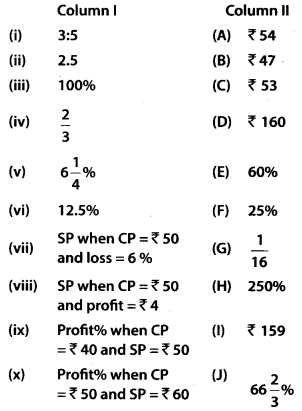
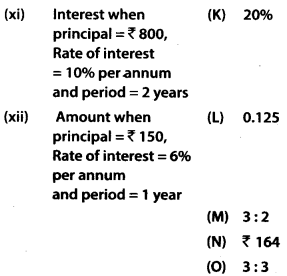
Solution:
(i) → (E)
(ii) → (H)
(iii) → (O)
(iv) → (J)
(v) → (G)
(vi) → (L)
(vii) → (B)
(viii) → (A)
(ix) → (F)
(x) → (K)
(xi) → (D)
(xii) → (I)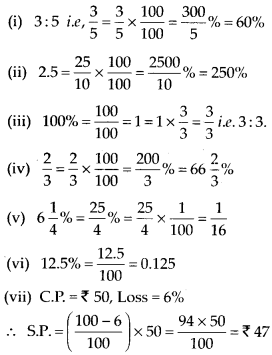
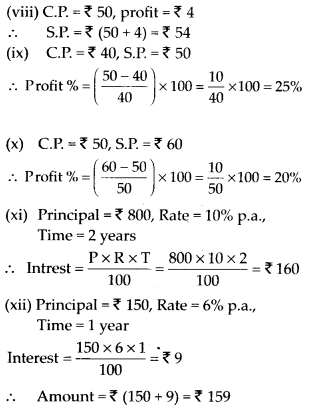
Q.130. In a debate competition, the judges decide that 20 percent of the total marks would be given for accent and presentation. 60 percent of the rest are reserved for the subject matter and the rest are for rebuttal. If this means & marks for rebuttal, then find the total marks.
Solution: Let the total marks be x,
Marks for accent and presentation -20% of x
Q.131. Divide Rs. 10000 in two parts so that the simple interest on the first part for 4 years at 12 percent per annum may be equal to the simple interest on the second part for 4.5 years at 16 percent per annum.
Solution: Total amount which has to be divide = Rs. 10000
Let first part be = Rs. x
Then, second part = Rs. (10000 – x)
Interest for second part
According to question,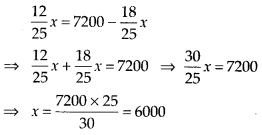
So, the first part = Rs. 6000
And second apart = Rs. (10000 – 6000) = Rs. 4000
Q.132. Rs. 9000 becomes Rs. 18000 at simple interest in 8 years. Find the rate percent per annum.
Solution: Principal = Rs. 9000, Amount = Rs. 18000,
Time = 8 years
∴ Interest = Rs. (18000 – 9000) = Rs. 9000
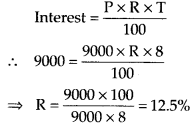
Q.133. In how many years will the simple interest on a certain sum be 4.05 times the principal at 13.5 percent per annum?
Solution: Let the principal be Rs. P.
Then, simple interest = Rs. 4.05 P
Rate = 13.5%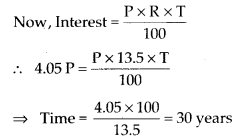
Q.134. The simple interest on a certain sum for 8 years at 12 percent per annum is Rs. 3120 more than the simple interest on the same sum for 5 years at 14 percent per annum. Find the sum.
Solution: Let the sum be Rs. P.
Interest for 8 years at 12% per annum
Interest for 5 years at 14% per annum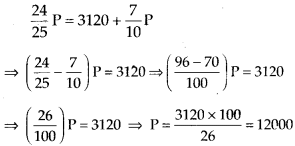
Q.135. The simple interest on a certain sum for 2.5 years at 12 percent per annum is Rs. 300 less than the simple interest on the same sum for 4.5 years at 8 percent per annum. Find the sum.
Solution: Let the sum be Rs. P.
Interest for 2.5 years at 12% per annum
Interest for 4.5 years at 8% per annum
According to question,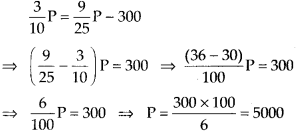
Q.136. Designing a Healthy Diet When you design your healthy diet, you want to make sure that you meet the dietary requirements to help you grow into a healthy adult.
As you plan your menu, follow the following guidelines
1. Calculate your ideal weight as per your height from the table given below this question.
2. An active child should eat around 55.11 calories for each kilogram desired weight.
3. 55 percent of calories should come from carbohydrates. There are 4 calories in each gram of carbohydrates.
4. 15 percent of your calories should come from proteins. There are 4 calories in each gram of proteins.
5. 30 percent of your calories may come from fats. There are 9 calories in each gram of fat.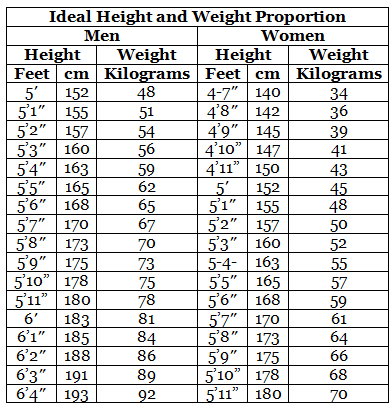
Solution: Let the height of a girl student of 7th class be 5 feet.
(1) Ideal weight – 45 kg
(2) Quantity of calories needed = 45 × 55.11 = 2479.95 calories
(3) Calories that should come from carbohydrates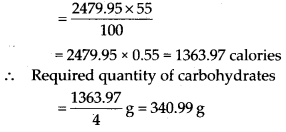
(4) Calories that should come from proteins
(5) Calories that may come from fat.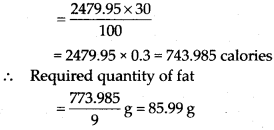
Q.137. 150 students are studying English, Maths or both. 62 percent of students study English and 68 percent are studying Maths. How many students are studying both?
Solution: Total number of students = 150
Number of students studying English
Number of students studying Maths
∴ Number of students studying both subjects = (93 + 102) – 150 = 45
Q.138. Earth Science: The table lists the world’s 10 largest deserts.
(a) What are the mean, median and mode of the areas listed?
(b) How many times the size of the Gobi Desert is the Namib Desert?
(c) What percentage of the deserts listed are in Asia?
(d) What percentage of the total area of the deserts listed is in Asia?
Solution: (a) Total area of 10 Deserts = 8800000 + 1300000 + 1250000 + 850000 + 580000 + 370000 + 320000 + 310000 + 310000 + 260000 = 14350000 km2
Since, n = 10 which is even
Since, area = 310000 km2 occurs two times.
∴ Mode = 310000 km2
(b) Area of Gobi Desert = 1300000 km2
Area of Namib Desert = 310000 km2
Now, 1300000 = x × 310000
So, size of the Gobi Desert is 4.19 times the Namib Desert
(c) Total number of Deserts = 10
Deserts listed in Asia = 5
(d) Total area of Deserts listed in Asia = 1300000 + 850000 + 320000+ 310000 + 260000 = 3040000 km2
Total area of all Deserts = 14350000 km2
Percentage of Deserts in Asia
Q.139. Geography Application: Earth’s total land area is about 148428950 km2. The land area of Asia is about 30 per cent of this total. What is the approximate land area of Asia to the nearest square km?
Solution: Earth’s total land area = 148128950 km2
Land area of Asia = 30% of 148428950 km2
Q.140. The pieces of Tangrams have been rearranged to make the given shape.
By observing the given shape, answer the following questions:
What percentage of total has been coloured?(i) Red (R) = _______
(ii) Blue (B) = _______
(iii) Green (G) = _______
Check that the sum of all the percentages calculated above should be 100.
If we rearrange the same pieces to form some other shape, will the percentatge of colours change?
Solution: (i) Total traction for Red (R)
∴ Percentage of red colour = 37.5%
(ii) Total fraction for Blue (B)
∴ Percentage of blue colour = 50%
(iii) Total fraction for Green (G)
∴ Percentage of green colour = 12.5%
Now, sum of all percentage
= 37.5% + 50% +12.5% = 100%
If we rearrange the same pieces to form some other shape, then percentage of colours will not change.
|
76 videos|386 docs|39 tests
|
FAQs on NCERT Exemplar Solutions: Comparing Quantities - Mathematics (Maths) Class 7 (Old NCERT)
| 1. How do you calculate the percentage increase or decrease in quantities? |  |
| 2. What is the difference between simple interest and compound interest when comparing quantities? |  |
| 3. How can you use ratios and proportions to compare quantities effectively? |  |
| 4. Can you explain the concept of cost price, selling price, and profit margin when comparing quantities? |  |
| 5. How can one effectively use discounts and mark-ups when comparing quantities in a business context? |  |






















